October and insects are becoming more difficult to find. Sure enough, there are always the Red Admirals to be seen feasting on the abundant ivy but on the whole it seems that most creatures have taken to more secretive activities. So the gall wasp larvae are busy munching away on the inside of the gall infested oak leaves, while leaf-miner moth larvae, not wanting to be left out, are also busy mining away and creating a network of internal canals within the dying leaves. All this is happening mysteriously away from sight within the dark and safe confines of their encased entombment. Indeed, most larvae have now changed to pupae as they mysteriously go through one of nature’s most radical transformations emerging as completely different forms. Not all cocoons lie hidden underground and looking carefully amongst the leaves you may be lucky enough to find a butterfly chrysalis or even (as I was fortunate enough to find) a ladybird pupa!
What follows is a series of images that documents the ladybird metamorphosis, from day 1 to day 14. The pupa was found in my local park and carefully transported home. All captures were taken with a Canon 7D, Canon MP-E 65mm Macro lens set at 2x magnification and using two heavily diffused flashes. Shortly after emergence and once the ladybird had hardened I released it back to near the spot where I initially found it.
PLEASE CLICK TO ENLARGE IMAGES
Day 1: The larvae has attached itself to the topside of a leaf by its hind end and has contracted into something of a dome-shape. This ‘hunched-up’ form is a characteristic of the pupal state and the metamorphosis from pupa to ‘imago’ took 14 days.
Day 2a: The transformation from orange to black is well on its way. It was well past midnight when I took this shot. The following morning the pupa was black.
Day 2b: After standing-up the pupa begins to hunch-up on itself and will form a domed-like posture. This is the resting position in which its more vulnerable body parts are protected. Within the next couple of hours its orange colour will gradually change into black. This has now started to happen.
Day 2c: From this low angle the characteristic, albeit rudimentary parts of the ladybird are starting to form into recognizable features i.e. eyes, palps, legs etc. The pupa has broken out of its larval skin. What was formerly a spiky, hunched-up larvae has now folded up, concertina fashion and forms the black base from which the pupa emerges. At this early stage, the pupa is bright orange and appears like a jelly mould, displaying some of the rudimentary parts of the forming ladybird.
Day 2d: The transformation from orange to black is well on its way. Another hour or so and it will be black!
Day 3a: The next morning the Pupa had turned from orange to black. From the front view one can make out the rudimentary shape of what will in 11 days become the pronatum. The head is safely tucked under and hidden from view.
Day 3b: From time to time the pupa will erect itself to reveal its elementary underbody parts. These are now starting to resemble recognizable ladybird features. The the black and spiky, root-like base from which the pupa appears to be sprouting from is what is left of the larva body.
Day 4 to 13: The pupa went through the same ritual. Most of the time it would be hunched-up in the dormant state only to spring into activity by gradually rising itself up! Although I have captured every single day’s growth I don’t want to bore you with repetitious images so here I have jumped to day 13. As you can see the pupa has grown in size and the emergence of the imago is immanent!
Day 4 to 12: There was the usual ritual of activity. However, the pupa appeared dormant from day 8 to 11 and I was beginning to worry that perhaps it had died. I needn’t have worried because on day 12 it sprung back to life again. This capture is from day 12 and shows the pupa beginning to rise from its four days of inactivity.
Day 13: This clearly shows how far the pupa has developed since day 1. In the course of watching the pupa develop I have learnt that the pupa isn’t an ‘immobile blob’ as is often described but is constantly changing and transforming itself, while its days are punctuated with moments of sprouting-up. From this upright position it is more vulnerable to prey and so will drop down to its hunched-up position at the slight detection of any movement. Day 14 was the big day when the ladybird finally burst out of its pupal case.
Ladybird Emergence
Day 14: The pupa begins to extend and split. Luckily for me I had two pupas developing at the same time which improved the chances of capturing this magical moment! I was lucky with this one. I wasn’t so lucky with the other pupa which emerged when I wasn’t around. Both ladybirds developed into different types of Harlequins so it was interesting seeing how their colouration and spots emerged.
The split becomes larger as the pale orange shell of the ladybird is seen emerging.
As the ladybird thrusts itself forward its pronatum also becomes apparent. Due to the angle of the shot its head is hidden from view.
Most of the ladybird has now emerged, it just needs one last push to free-up its back end! At last free! Not the most attractive of positions. Just needs to turn 180 degrees so that we can see his head and not rear end!
Eureka! The ladybird has turned to reveal his handsome yet pale features. These soft pastel shades are typical of newly emerged ladybirds.
At last the ladybird turned almost 360 degrees to finally face the camera. It then left behind the exuvia to investigate its new environment. This is a very dangerous time for a young ladybird as its body is soft and particularly appealing to predators.
In the next sequence I will show how the ladybird gradually changes colour and gets its spots. We then should hopefully be able to identify it.
The recently emerged ladybird leaves behind its empty pupal case to explore its new environment. The ladybird is still translucent as its exoskeleton hasn’t hardened up yet. Notice how the wings are left exposed. It may seem strange to leave the wings unprotected by the elytra at this vulnerable stage but the wings are too soft for flight and they need to be exposed to the air in order to harden.
The elytra (shell) also needs to harden, change colour and grow spots, for what good is a ladybird without its characteristic spots! As the wings and elytra harden simultaneously, the wings gradually begin to retract into their protective casing. The ladybird’s elytra is starting to darken and spots are starting to become visible. Within an hour or two the shell will be transformed.
The ladybird sat motionless in this position while its pale orange and translucent elytra changed into a hard, glossy and black shell with red spots!
It’s clear by now that the newly emerged ladybird is of the invasive Black Harlequin variety.
It is estimated that 25% of the UK harlequin population is made up of black harlequins (BBC News Magazine). I could tell already that this was a considerably larger ladybird than the orange and red variety not to mention the native two and seven spot species. Unfortunately the black harlequin is very invasive and will eat other smaller ladybirds as well as larvae and eggs of other insects.
This Darth Vader of the ladybird world will become an awesome predator.
From this angle one can clearly see that it’s a Black Four Spot Harlequin. Notice how the dull and matt-like parts of the shell are now almost completely glossy. At this stage I had to increase the diffusion in order to avoid specular highlights

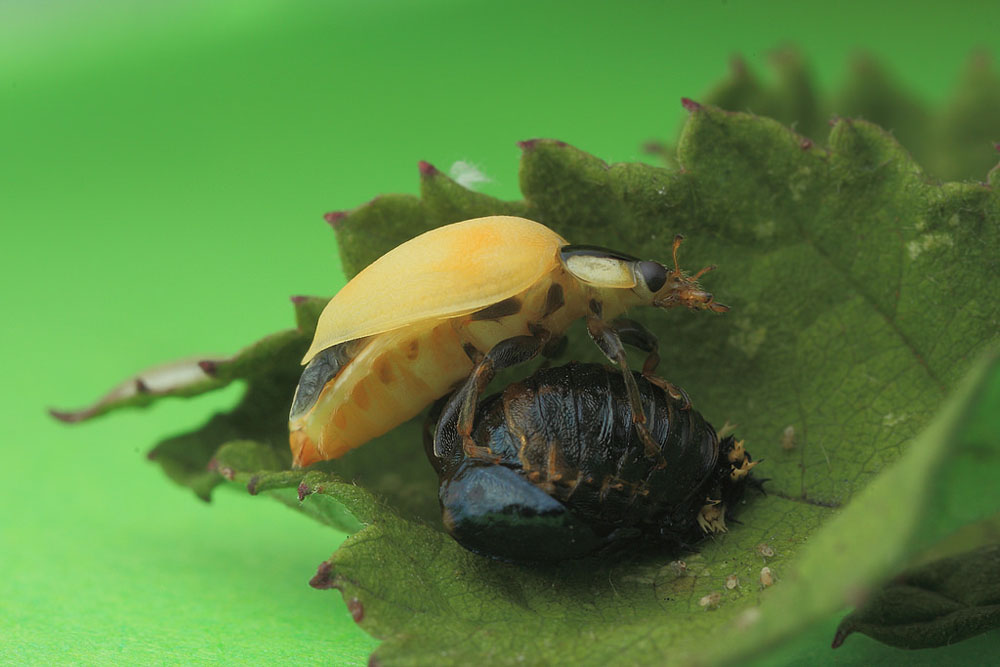
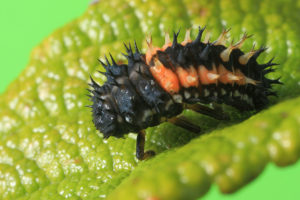
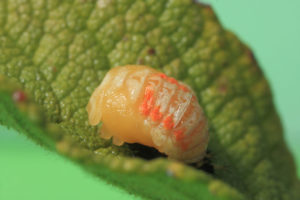
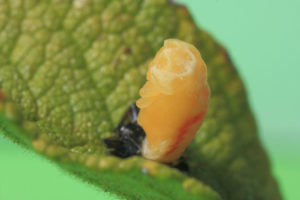
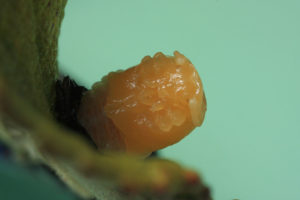
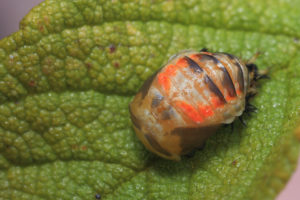
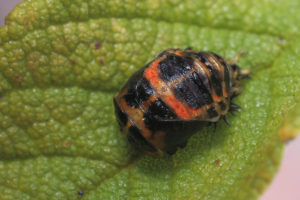
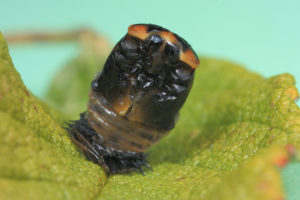
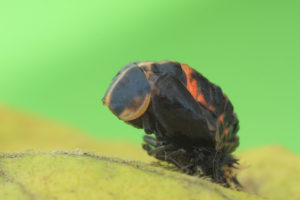
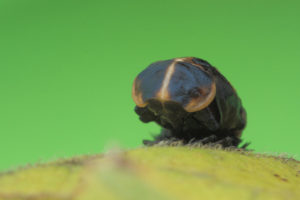
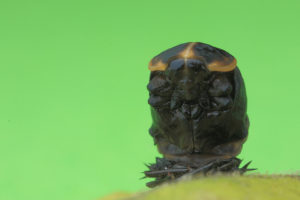
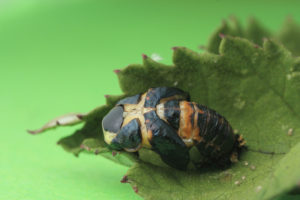
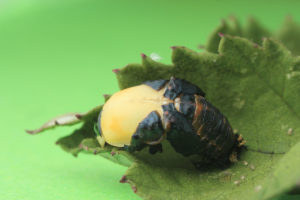
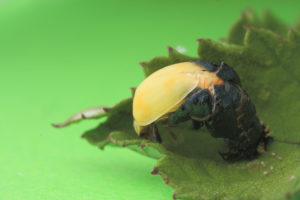
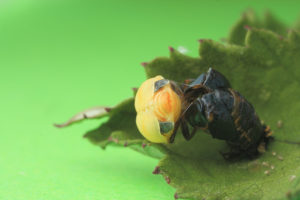
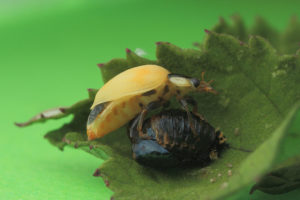
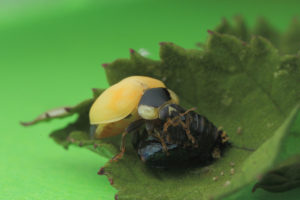
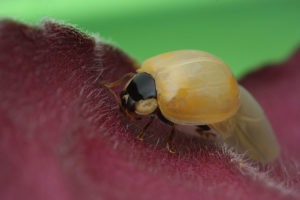
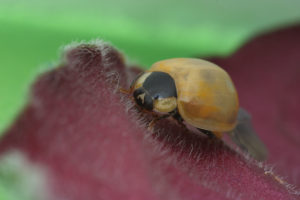
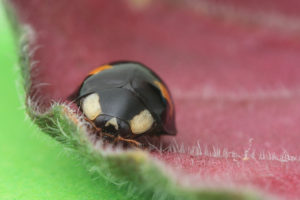
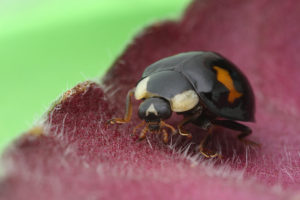
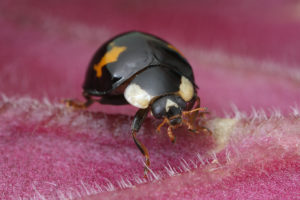
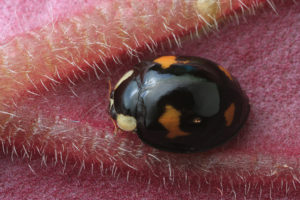
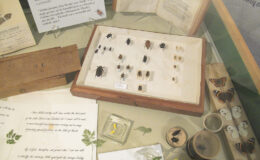
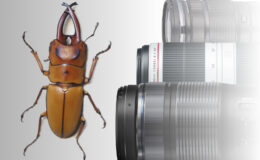
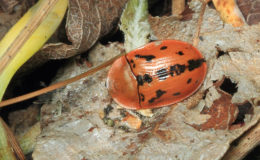
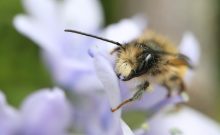
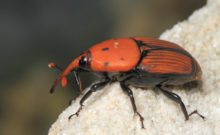
Leave a Comment